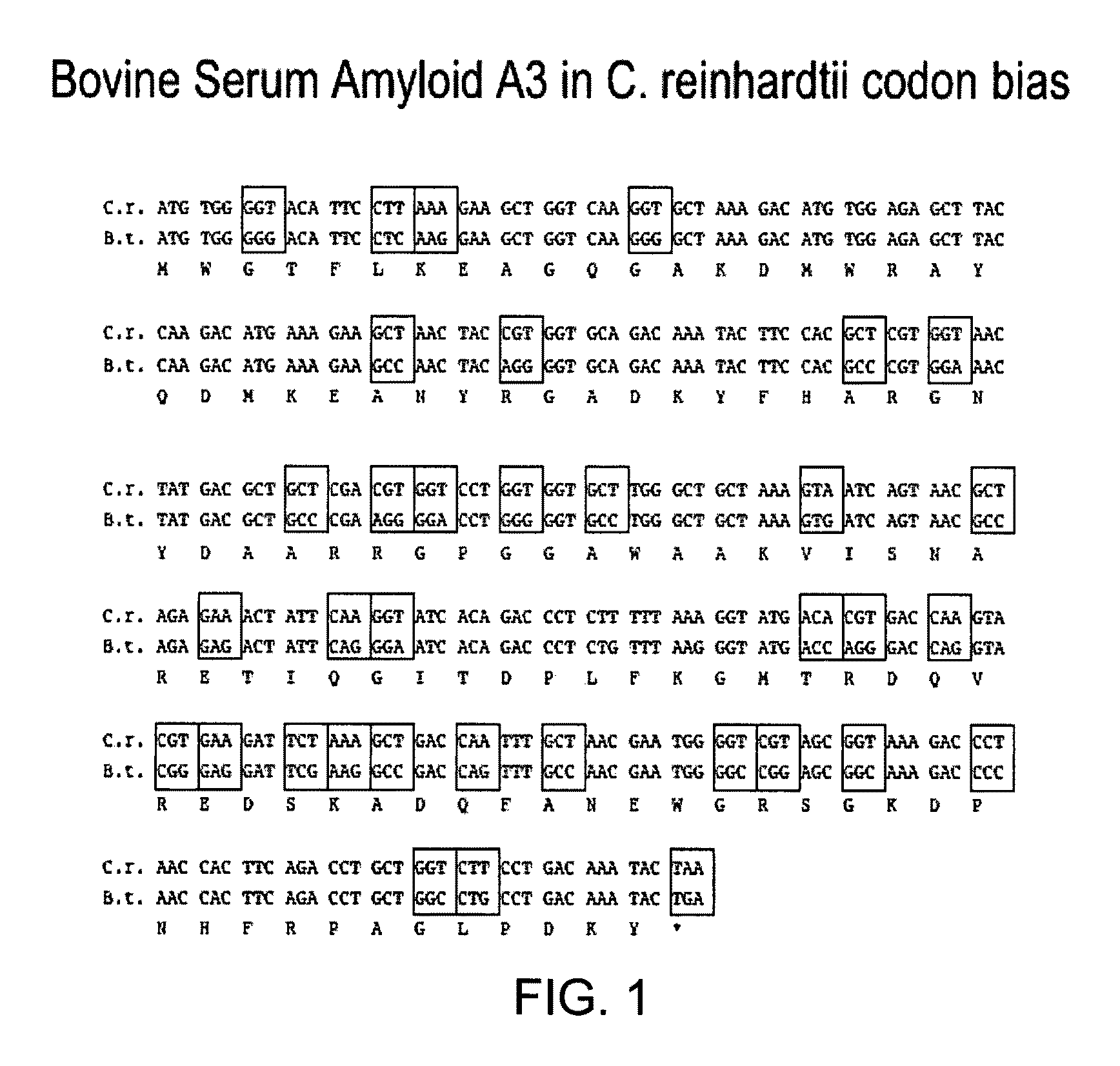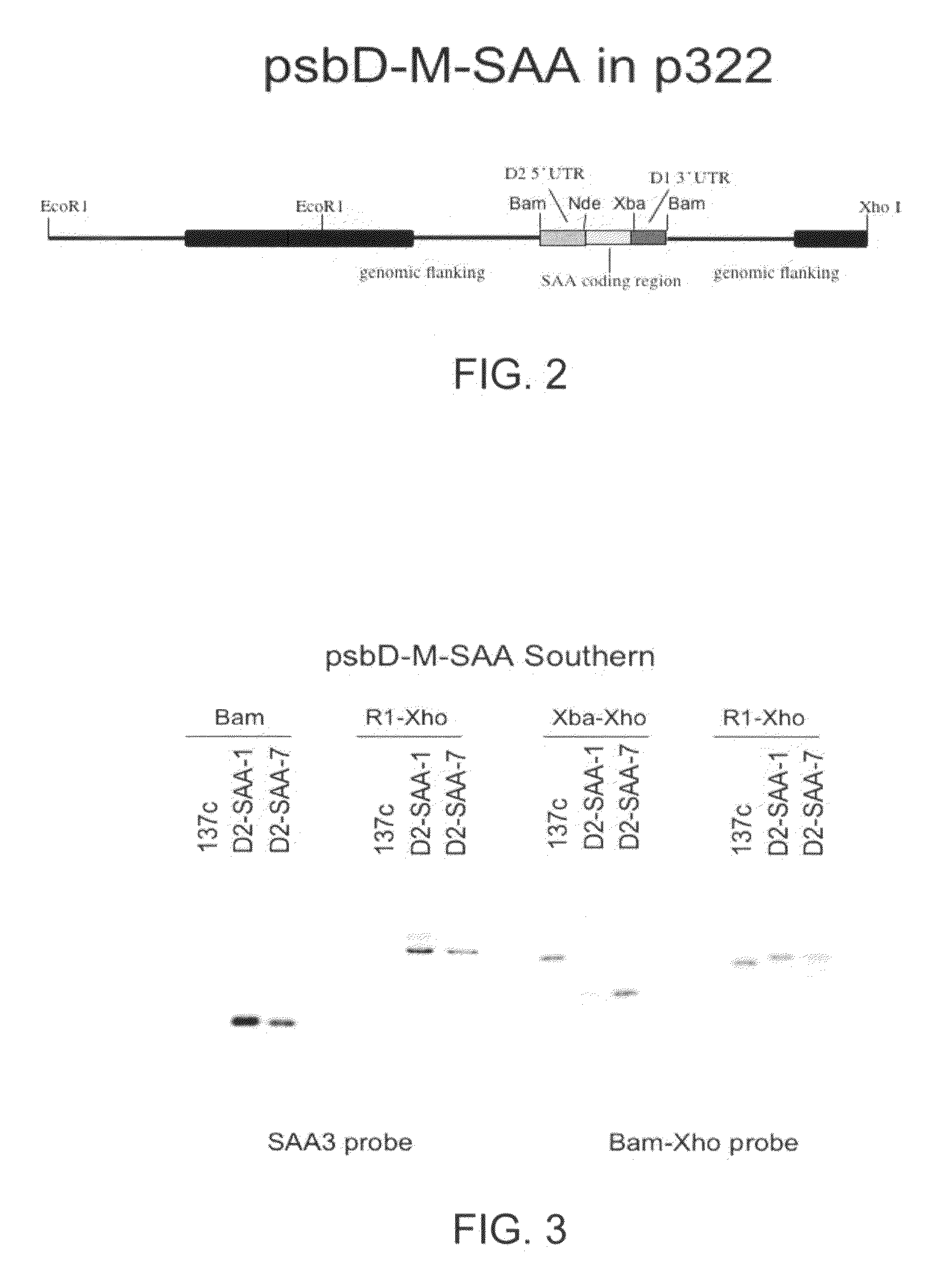Robust expression of a bioactive mammalian protein in chlamydomonas chloroplast
a bioactive, mammalian technology, applied in the direction of animal repellents, drug compositions, algae medical ingredients, etc., can solve the problems of time-consuming and expensive inherent high cost of goods and capital investment associated with the production of these molecules, and the need for more efficient and rapid production systems. achieve the effect of eliminating competition or autoregulation of transgenes, effectively controlling gene expression, and robust expression of exogenous gene products
- Summary
- Abstract
- Description
- Claims
- Application Information
AI Technical Summary
Benefits of technology
Problems solved by technology
Method used
Image
Examples
example 1
Materials and Methods
C. reinhardtii Strains, Transformation and Growth Conditions.
[0117]Transformations were carried out on C. reinhardtii wild type strain 137c (Franklin et al., Plant J. 30 (2002) 30:733-744). Cells were grown to late log phase (approximately seven days) in the presence of 40 mM 5-Fluorodeoxyuridine in TAP medium (Gorman and Levine, Proc Natl Acad Sci USA (1965) 54:1665-1669) at 23° C. under constant illumination of 4,000 lux (high light) on a rotary shaker set at 100 rpm. 50 ml of cells were harvested by centrifugation at 4,000×g at 4° for 5 min. The supernatant was decanted and cells resuspended in 4 ml TAP medium for subsequent chloroplast transformation by particle bombardment as described previously in Cohen et al. (Meth Enzymol (1998) 297:192-208). All transformations were carried out under spectinomycin selection (150 μg / ml) in which resistance was conferred by co-transformation with the spectinomycin resistance ribosomal gene of plasmid p228 (Chlamydomonas ...
example 2
De novo Synthesis of a Bovine Mammary Associated Serum Amyloid A3 Gene in C. reinhardtii Chloroplast Codon Bias
[0123]In order to obtain high levels of protein expression in algal chloroplast synthesis of coding region in codons optimized to reflect abundantly expressed genes of the C. reinhardtii chloroplast (Franklin et al., 2002, supra; Mayfield and Schultz, Plant J (2004) 37:449-458) was required. The chloroplast mammary associated serum amyloid A3 gene (M-SAA3, FIG. 1) was designed based on the M-SAA3 gene from bovine (McDonald et al., Vet Immunol Immunopathol (1999) 83:203-211). The M-SAA3 sequence was obtained from Genbank (AF335552), and a series of oligos were designed based upon this amino acid sequence, but changing codon usage to reflect those of highly expressed C. reinhardtii chloroplast genes. The gene was assembled using PCR by the method of Stemmer et al. (1995, supra). PCR products were cloned into E. coli plasmids, the synthetic gene sequenced, and errors corrected...
example 3
Construction of an M-SAA3 Expression Cassette and Southern Blot Analysis of M-SAA3 Transformants
[0124]Once it was determined that the M-SAA3 coding sequence was correct, chloroplast M-SAA3 expression cassettes were constructed. An expression cassette containing the psbD promoter and 5′ UTR, and the psbA 3′ UTR was constructed initially. This construct was made because the psbD 5′ UTR gave the best expression, of five promoters examined, of a recombinant green fluorescent protein in transgenic chloroplast (Barnes et al., 2005, supra). The M-SAA3 coding sequence was ligated down stream of the psbD promoter and 5′ UTR, and upstream of the psbA 3′ UTR (FIG. 2). The chimeric psbD / M-SAA3 gene was then ligated into chloroplast transformation plasmid p322 (Franklin et al., 2002, supra) at the unique Bam HI site to create plasmid p322-psbD / M-SAA3 and transformed into wt C. reinhardtii.
[0125]Wild type C. reinhardtii cells (137c) were transformed with the p322-psbD / M-SAA3 plasmid and the sele...
PUM
| Property | Measurement | Unit |
|---|---|---|
| length of time | aaaaa | aaaaa |
| length of time | aaaaa | aaaaa |
| molecular weight | aaaaa | aaaaa |
Abstract
Description
Claims
Application Information
 Login to View More
Login to View More - R&D
- Intellectual Property
- Life Sciences
- Materials
- Tech Scout
- Unparalleled Data Quality
- Higher Quality Content
- 60% Fewer Hallucinations
Browse by: Latest US Patents, China's latest patents, Technical Efficacy Thesaurus, Application Domain, Technology Topic, Popular Technical Reports.
© 2025 PatSnap. All rights reserved.Legal|Privacy policy|Modern Slavery Act Transparency Statement|Sitemap|About US| Contact US: help@patsnap.com



